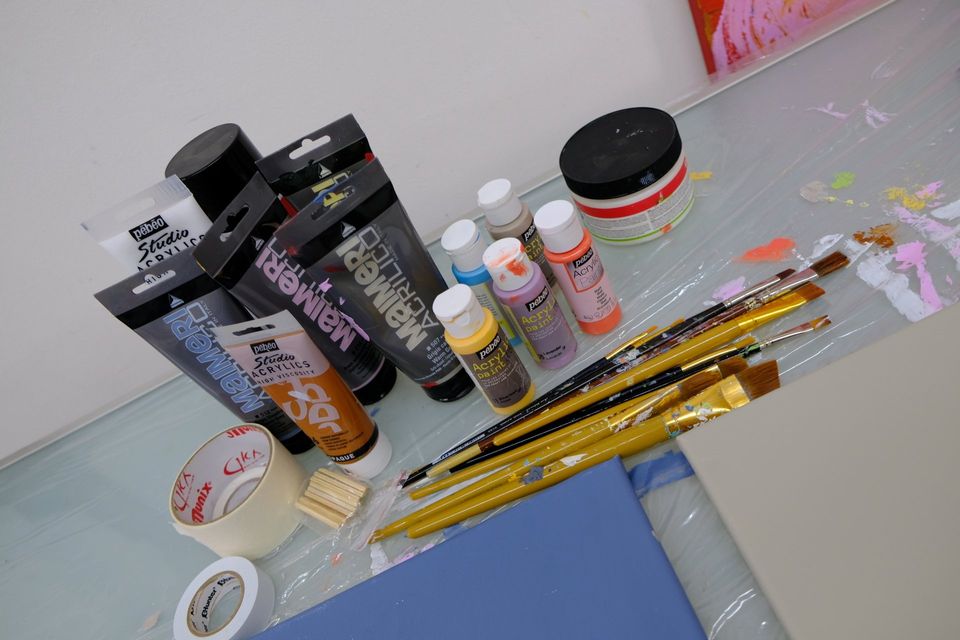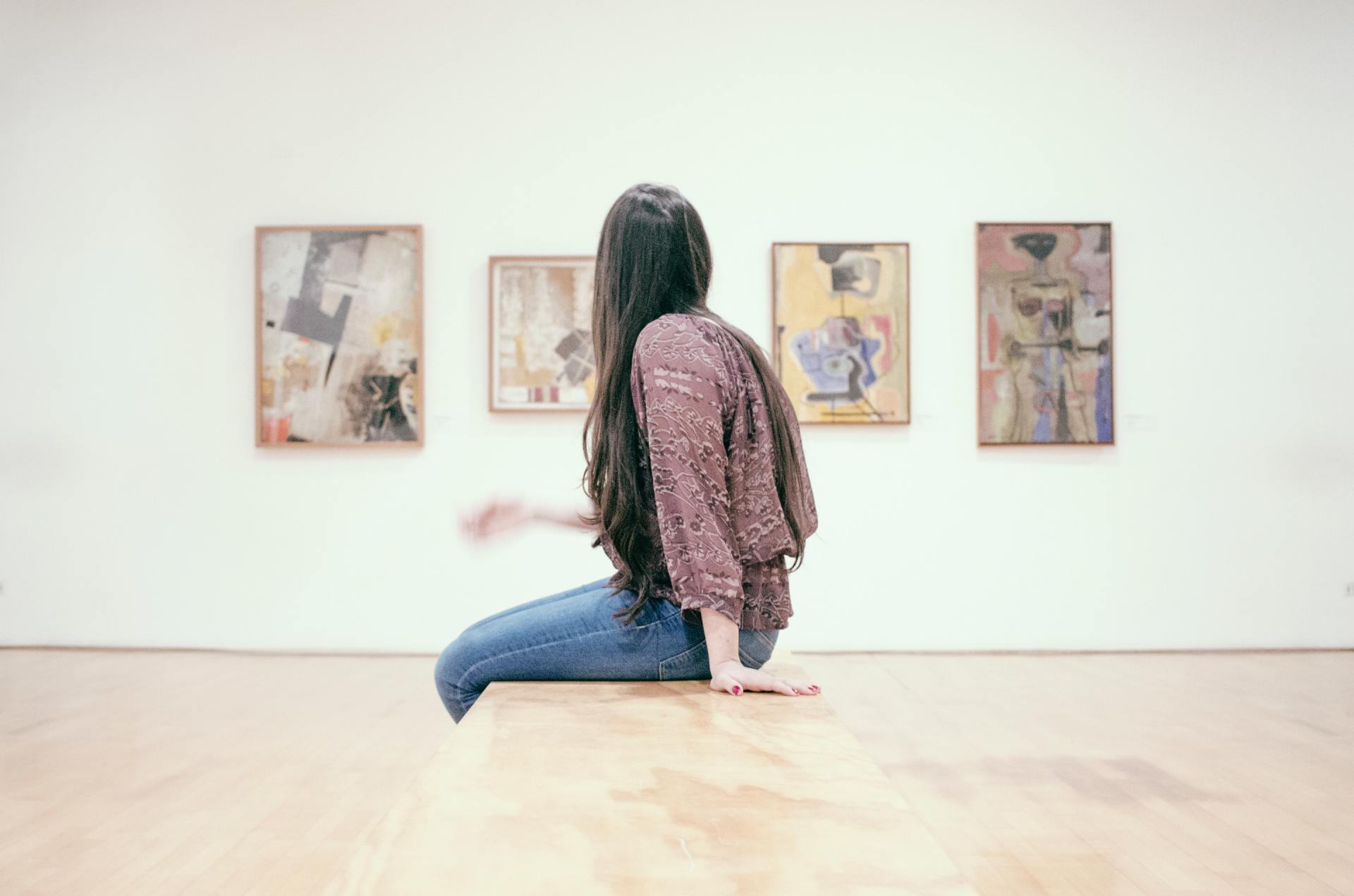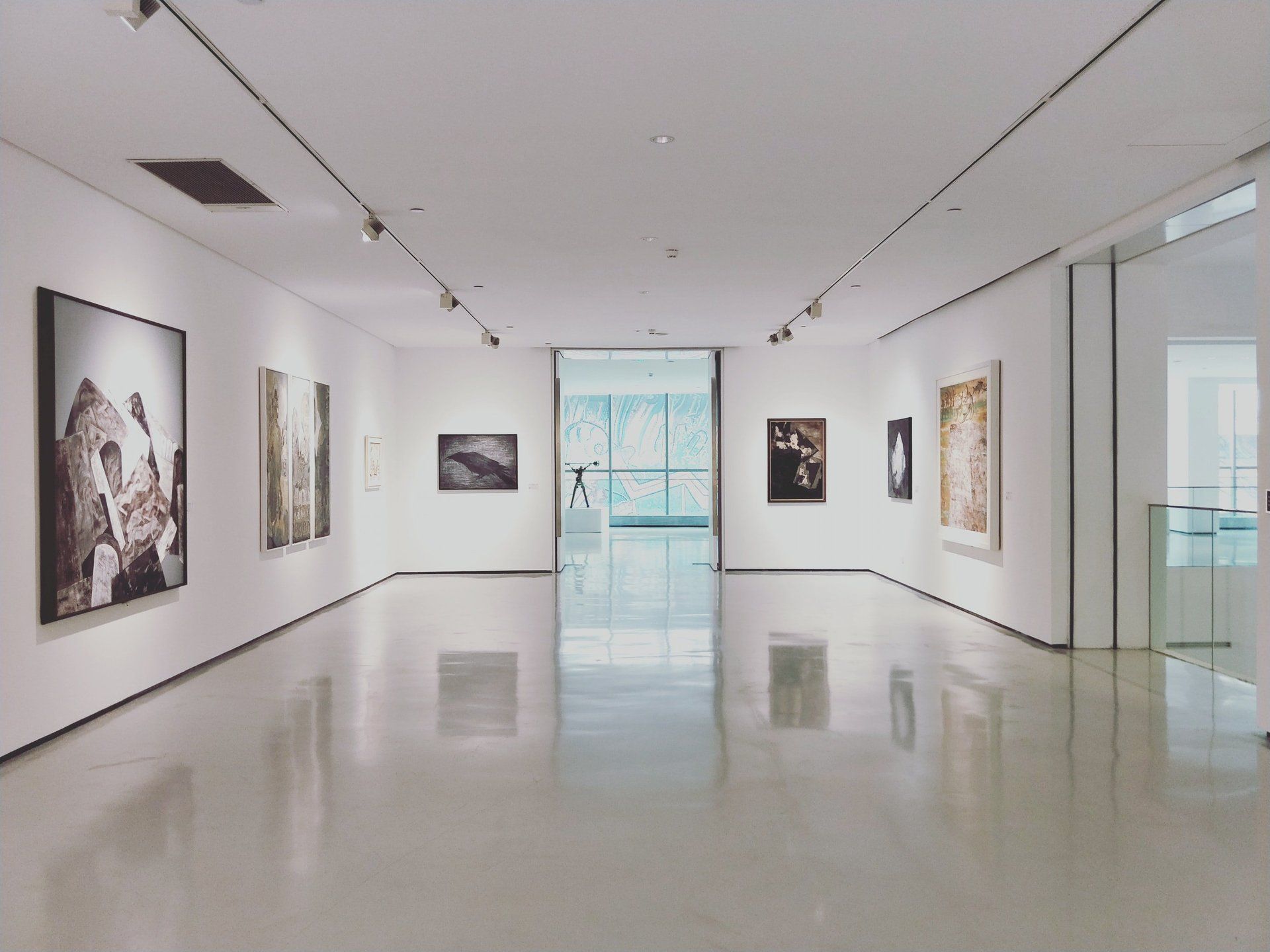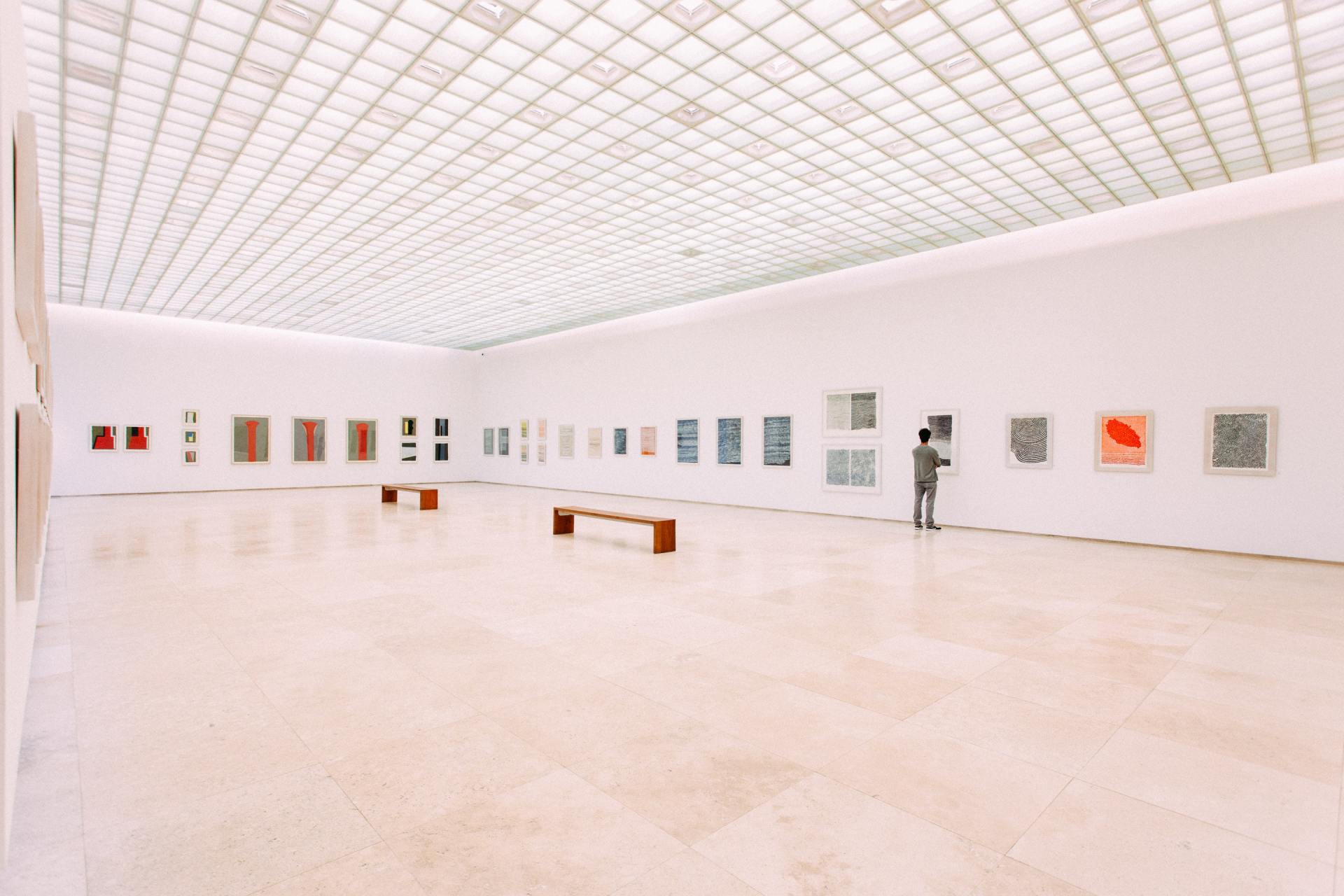Advantages of working with acrylic paint
Korinna Janssen • February 6, 2021
Advantages of Acrylic Paint

Why I work with acrylic paint.
As a painter, I like experimenting with mediums and materials, like aquarelle paint, oils and acrylic paint. Acrylic paint is a fairly recent medium compared to the long-standing traditions of oil and watercolor painting. By the 1950s acrylic paint became commercially available and it has greatly increased in popularity since then, with new colors and mediums being introduced regularly and the quality is improving every year.
I find that acrylic paint suits both my painting style and life style best for bunch of reasons. I this blog I will explain why acrylics are my go-to material.
What is acrylic paint?
Acrylic paint is one of the most versatile mediums, and one of the least toxic. It is water-soluble when wet and yet because it is a plastic polymer, dries into a flexible, water-resistant, and durable surface to which subsequent layers of paint can be added without disturbing the underlying layers.
Acrylic paint is fast drying
What is most notable about regular acrylic paint is its fast drying time. Since it dries quickly,
These characteristic suits my life style very well. I’m a mother of 2, I’s responsible for a household and I’m also holding a fulltime job. This characteristic allows me to work relatively quickly in shorter session. It helps me to make the most out of valuable studio time.
Secondly, because of the fast drying time, I can work in multiple successive layers without muddying the colors. I like working with clean (hard-edge style) lines and using tape and a hairdryer, I can set up multiple layers in one session. Once acrylics are dry they can support a new layer immediately.
Sometimes a spray bottle of water is needed to slow down the drying time a bit, both on the painting and on the palette. I find it useful to spray the back side of the canvas to keep a bit of humidity. If you do not like this characteristic, or at least would like to have more control, there are also acrylic mediums that will retard the drying time and enable you to paint wet-on-wet.
Acrylic paint can be used on many surfaces
With acrylic, you are not limited to canvas or wood. Acrylics have the ability to bond to many different surfaces, and mediums can be used to modify its binding characteristics Acrylic can be used on paper, plastic, canvas, wood, cloth, concrete, and brick. You can paint on any surface that is oil and wax free.
.In case the surface is porous (or too smooth/glossy like metal or glass), water will be absorbed into the surface, so in order to apply the paint more smoothly, it is a good practice to prime the surface with gesso or another primer beforehand.
Acrylic paint can be purchased in a large variety of colors
Acrylic paint comes in tubes, jars, in plastic squeeze bottles, and in small ink-bottles. It also comes in a variety of different thicknesses, those in tubes being the most viscous and most like oil paint.
What I love, is the huge variety of subtle colors available today. The prices are usually quite affordable. If you like a certain color or you can go and buy yourself the exact same one, without the need to mix. My favorite brands like AMSTERDAM, PEBEO and MAIMERI, depending on the availability.
It is extremely important to make sure the paint is sealed properly in order to keep the paint from drying out. You will need to clean the caps of your tubes regularly, as the paint will dry in a plastic blob around the opening. This prevents the tubes from closing well.
Acrylic paint is non-toxic and has no odor
Acrylic paints are water-based, which means they can be thinned with just water (no toxic spirits are required). In addition, acrylic paint is water-soluble, so wet paint can be cleaned off of brushes using just soap and water. I’ve had paint on my face and hands and I’ve never observed any harmful effects. With oils and turpentine, that’s’ a different story.
Acrylic as underpainting
It is quite flexible and is not likely to flake, chip, or crack. Acrylic paint It is often used as underpainting, even for when the top layer is oil paint. Be careful, though: you can’t use acrylic paint on top of oil paint!
Acrylic paints is durable
Acrylic paints hold their colors very well and even after many years, the quality is still really good. I like that I can simply wipe the painted canvas with a moist cloth if I wish to clean it. Although the surface of acrylics can be a bit oft, acrylics have proven advantages in terms of resistance to yellowing and long term flexibility
Written by: Korinna Janssen. artist.
KOKO Art Print - Blog by artist Korinna Janssen

Purchasing an original fine art piece for your home is one of the most striking ways to elevate your living space immediately to a higher level , however it traditionally comes with a pretty hefty price tag. An great affordable alternative to buying original art, is purchasing a fine art giclée print. Such an art print makes it possible to enjoy gorgeous artwork almost on the level of the original piece, without having to sacrifice quality for a lower price tag. The popularity of giclée prints has completely changed the game by making fine art accessible to those of us who can't afford original paintings. You might be asking yourself: " what are giclée prints?" Don't worry — in this guide, we'll explain it all. What Are Giclée Prints? Giclée, pronounced "zhee-clay," is a French word that means squirt or spray. In 1991, printmaker Jack Duganne coined the term giclée printing to describe the process of using inkjet printers to create high-quality, archival art prints . The printers used to make giclée prints aren't your average household inkjets. The typical inkjet printers that you would find in an office or a home hold usually between two to four color cartridges. This is perfectly fine for everyday use, but when it comes to fine art prints more cartridges are needed to capture detail. Wide-format inkjet printers used for giclée prints can hold about two to three times more color cartridges than household machines. Eight to twelve cartridges allow for a printer to reproduce artwork with more accuracy and faithful detail. The wide-format inkjet printers used to reproduce artwork are also larger than regular models, allowing artists to create a large range of sizes for their giclée reproductions. With one of these specialized inkjets, artists can create stunning gallery-sized prints along with standard print sizes like A4 or 8.5"x11". What Goes into the Production of Giclée Prints? Making a fine art print, especially if it's a reproduction of a physical piece of art and not a digital painting, requires more work than just taking a photo of your work and pressing send. The artwork needs to be scanned by a scanner both large enough to capture the entire image and powerful enough to transfer the detail into a print. DPI is a common way to measure image resolution and stands for dots per inch. When it comes to creating giclée prints, the resolution should be 300 DPI at the very least. Once the art is scanned, it can be taken to a giclée printing service and reproduced into gallery-quality artwork. The journey doesn't end there though — there are still many different decisions that the artists must make in order to create the best prints that they possibly can. There are many different paper and ink types that can be used to make giclée prints, but the most important element when it decided which materials to use is that they are archival quality. Archival ink is resistant to fading and weathering. The ink used in giclée prints must also be pigmented ink instead of dye ink. While they both can produce excellent colors, dye inks are water-soluble and more vulnerable to degradation. Pigmented inks stand the test of time. Archival paper is acid-free, which means it won't break down as easily as regular paper. There is a variety of paper types used in giclée printing, but some of the most common are cotton, canvas, and watercolor papers. Why Are Giclée Prints Valuable? Giclée prints are more than just a method of reproducing art in large quantities, they are actually a form of fine art themselves. Giclée printmaking is a hybrid between traditional art and technology and the final product is up to the discretion of the artist themselves. Understanding the way that ink and paper interact with each other, and which options will enhance the original art design in the most impactful way, are important decisions to make that elevate both the quality of the print and the process of printmaking itself. The quality of the materials and equipment used to create a giclée print also add to the value. Giclée prints are like high-end designer clothing pieces. While the couture gown that you purchase from the department store isn't the original mockup hand-sewn by the designer themselves, you can rest assured that it was created with the highest quality materials and constructed by expert hands. In the same way that a couture gown is a valuable reproduction of an original design, a giclée print is a valuable reproduction of an original work of art. A lot of expertise and care goes into creating each print, and that is reflected in both the quality and value of the reproduction. Not to mention, giclée prints last a lifetime! Since they are created with archival, museum-quality materials, you aren't just purchasing décor , you're purchasing artwork that will last generations. Giclée Prints vs. Digital Prints At face value, giclée and digital prints might seem similar. However, the difference really boils down to the quality and longevity of the print. Digital prints are also created using digitized versions of original artwork, whether it be traditional or digital art. But digital prints aren't created with the same technologies used in giclée printing techniques. They don't use the same amount of different color cartridges as printers used for giclée printmaking do, which means that the color quality and detail will be much weaker in comparison to the original work. Digital prints also don't use archival ink or paper, so your print is more vulnerable to fading and degrading over the years. If you took a magnifying glass to a digital print and a giclée print, you'll find that the digital print has a much lower resolution, less sharpness, and more missed detail. Giclée isn't the only method of reproducing an original artwork, but it is the only method that will give you an affordable, museum-quality art print that you will treasure for a lifetime (and beyond)! Where to Find Vibrant Giclée Art Prints One of the best features of a giclée art print is its vibrancy. The combination of quality ink, paper, and DPI results in artwork that truly shines, with rich colors and saturation. If you are looking for museum-quality modern art prints that will liven up your home, browse our limited edition giclée print collection. Find a piece that speaks to you.




